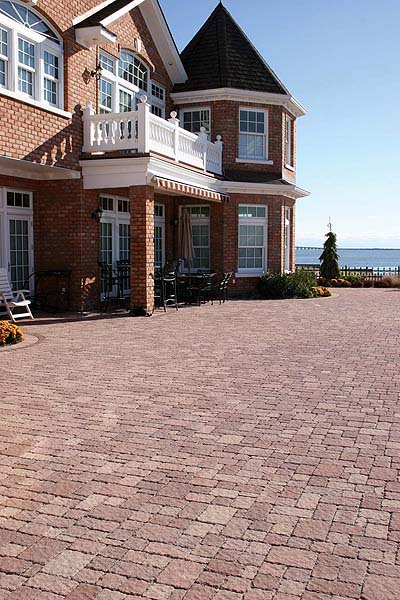
To pave or not to pave? When it comes to driveways, that is so often the question.
But in order to get the job done right on the East End, residents have to consider where they are first—before they make a decision between concrete, asphalt or paving stones.
“You have to remember, Long Island is one big sandbar,” Michael Montecalvo, owner of Montecalvo Paving in Speonk, explained during a recent telephone interview. “Basically, you can dig down and hit sand anyplace. The ground is always moving around.”
One way to combat the ever-shifting earth is by way of interlocking concrete pavers, which are pre-cast concrete blocks available in a variety of sizes and shapes that can be laid in different patterns and designs, according to Mark Fuss, vice president of sales and marketing for Lindenhurst-based paver manufacturer Nicolock.
Typically, the pavers are installed over a compacted stone base topped with a 1-inch-thick sand bed, resulting in pavement that’s “rigid, yet flexible, if that makes sense,” Mr. Fuss said.
“As the ground moves, your pavement moves with it and it won’t crack,” he said during a recent telephone interview. “A concrete slab will crack primarily because the ground is moving underneath. With pavers, you essentially have a crack around each unit, so you have a flexible system.”
Concrete pavers are typically more expensive than stone and gravel driveways, Mr. Fuss said, and start at $7.99 per square foot. But they have their advantages, he said. Not only do they have a shelf life of at least 25 years, the pavement comes in a variety of patterns and colors, he said.
Cobblestone—the original interlocking concrete paver, for example—gives a look of fine Italian tile, Mr. Fuss said, while the textured face and pillowed corners of Colonial Cobble offers an Old-World cobblestone feel. The Stone Ridge pavers have a subtle surface texture, much like the look of naturally cut flagstone.
This is not pavement usually found in commercial spaces, Mr. Fuss emphasized. The concrete used in the pavers is 2½ times harder than a poured concrete sidewalk or driveway, he said.
“Typically, that’s called ‘poured in place,’ where they frame it out with some lumber and pour concrete in it,” Mr. Fuss said. “We compact it. It’s a combination of the mix design—which is the combination of the raw materials, the recipe—and, also, when it’s manufactured, we compact it under high pressure to create a minimum 8,000 pounds per square inch concrete, as opposed to poured in place, which is typically 2,500 to 3,000 pounds per square inch.”
But that’s not enough to sell Mr. Montecalvo. He’s an asphalt guy.
“I’m not going to tell you concrete,” he said. “It’s more expensive. It may last longer, but it’s quite a bit more money.”
The primary difference between asphalt and concrete is that the former is made by mixing aggregate—construction material such as sand or gravel—with bitumen, a sticky, black, tar-like substance that is extracted from natural deposits or crude oil. The latter is made by mixing aggregate material with a cement binder and then allowing the mixture to harden, forming a rock-like substance.
Because Mr. Montecalvo operates an asphalt maintenance company, he wasn’t able to provide an asphalt estimate. But according to online reports, it averages about $3 per square foot on Long Island—and that’s a good thing, considering cracking is inevitable.
Seal coating, a preventative measure, runs between 15 and 25 cents per square foot, Mr. Montecalvo said, depending on the size of the job. The bigger the area, the less the square foot price, he said. The first application should be done the year after paving, and then every other year after that, he said.
“It’s a maintenance item, nothing you can do about it,” he said. “You have to take care of cracking as it happens. Some people call me and they want to seal coat, but when I get there, I see their driveway’s shot. It’s too late. You have to take care of it before you get to that point. It’s like the paint on your house. It peels off, you wait to take care of it 15 years later and it’s all rotted underneath. It’s that kind of thing.”
For year-round homes, Mr. Montecalvo recommends asphalt driveways, which, unlike decorative stones, resist snowplow damage. But Mr. Fuss insists that concrete pavers, especially permeable paving products, are a viable alternative. The snow melts faster because the voids around the pavers allow the water to percolate back into the soil, rather than create stormwater runoff—a major issue on the East End.
“The other thing is, for most homeowners, you can only cover so much of your property with non-permeable products. You can’t cover your whole yard with concrete because it creates too much runoff,” Mr. Fuss said. “There’s limits.”
In order to comply, certain permeable surfaces—including Turfstone and Checker Block, which start at $10 per square foot—allow grass coverage on driving surfaces. The latter is the only steel-reinforced concrete grid paving unit available on the market, according to Nicolock’s website. The waffle-like configuration provides significant grass coverage when properly filled with topsoil. Each 4-square-foot unit is 4 inches thick and can provide a 75 percent grass-to-concrete ratio, giving the effect of a green turf.
A paver shield manufactured into the concrete also protects against abrasive East End conditions, such as salt and snow. It’s a quarter-inch-thick concentration of sand, cement and pigment on the wear layer, Mr. Fuss said.
“The old-style paving stones have the aggregate from the top to the bottom, which we need to give the paver strength,” he explained. “So as the paver wore over time, it exposed the aggregate, and most people don’t like that look. With the paver shield, it keeps that from happening and keeps the colors rich and vibrant for the life of the pavement. It’s really the best possible pavement where you have freeze-thaw conditions. And guess what? We have freeze-thaw conditions.”